Our Site uses cookies to improve your experience on our website. For more details, please read our Cookie Policy.
By closing this message or starting to navigate on this website, you agree to our use of cookies.
This page is translated using machine translation. Please note that the content may not be 100% accurate.
PROPERTY MARKET TRENDS | 3Q 2021
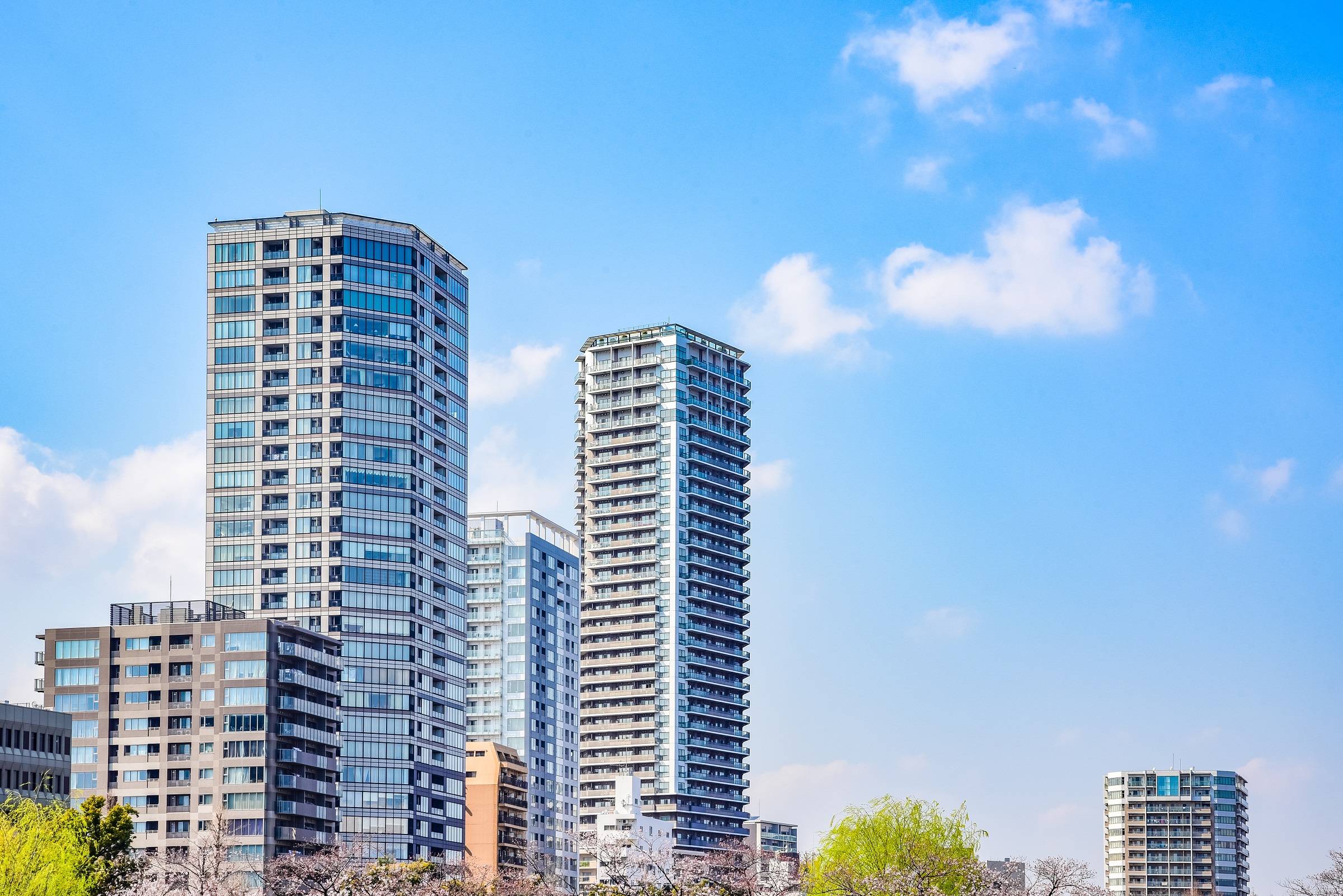
PROPERTY MARKET TRENDS | 3Q 2021
Residential: Markets for both new and secondhand homes stayed buoyant.
Office: Improvement in vacancy rates was observed in Tokyo and regional cities.
Logistics: A tight demand-supply situation may lead to further market expansion.
TEXT: Yoko Fujinami, ib Research & Consulting Inc.
Toru Kawana, Industrial Marketing Consultants Co., Ltd.
Residential
Average price of new condo.'s for sale in Tokyo metropolitan area remained at a high level of over JPY 3 million / Tsubo. Together with strong secondhand sales, the residential market overall has been buoyant.
■New condo. sales in Tokyo metropolitan area
・Average initial sales price, floor area, and unit price in January 2022 were JPY 61.57 million, 65.04 sqm, and JPY 3.124 million per tsubo respectively. The month-end inventory was 6,437units, and number of units newly supplied in the month was 1,128 units, down by 14.9% YoY. However, there was a large-size project coming on line in front of Yokohama station unaccounted for. Contract rate in the initial month of sales start was hovering in the range over 70% during the months of October thru December 2021, though it dropped below 60% in January 2022.
■New condo. sales in Kinki region
・Average initial sales price, floor area, and unit price in January 2022 were JPY 39.92 million, 53.57 sqm, and JPY 2.459 million per tsubo respectively. The month-end inventory was 4,083 units, and number of units newly supplied increased by 14.0% YoY. Contract rate has been firm steadily exceeding 70% since December 2021.
■Second-hand condo. sales in Tokyo metropolitan area
・There were only 2,760 contracts made in January 2022 (down 20.7% YoY), due to a gradual decrease in inventories and a contraction from the elevated level of transaction volumes during the first half of 2021. Average age of units sold was 22.72 yrs. Their average contract price and unit price both rose to JPY 41.49 million (up 10.0% YoY) and JPY 641.8 K per sqm (up 11.5% YoY) respectively. The number of units in inventory and newly listed were 36,632, and 12,597 respectively.
・As the price of new condominiums soars, the demand for second-hand condominiums is also rising, and the market is expected to stay strong in the future.
■Market overview
・There was a change in the for-rent residential market due to the impact of COVID-19. As a result of abolition of job transfers and unaccompanied postings by increasing number of major companies along with adoption of mobile work, demand for employee accommodations provided by companies for transferees plunged and contract rate fell.
・Studio-type units (25~26 sqm, rent @JPY 100,000+) in areas around Kamata / Ota-ku, and Kiyosumi-Shirakawa / Koto-ku were popular among workers in travel-related industry including airport personnel before COVID-19. However, a noticeable number of these units are now vacant because of a decline in the number of those workers. As an increasing number of people invested in real estate with a view to reducing tax and their primary targets were studio-type units, there was an oversupply of them even before COVID-19. The situation is likely to stay tough for the time being.
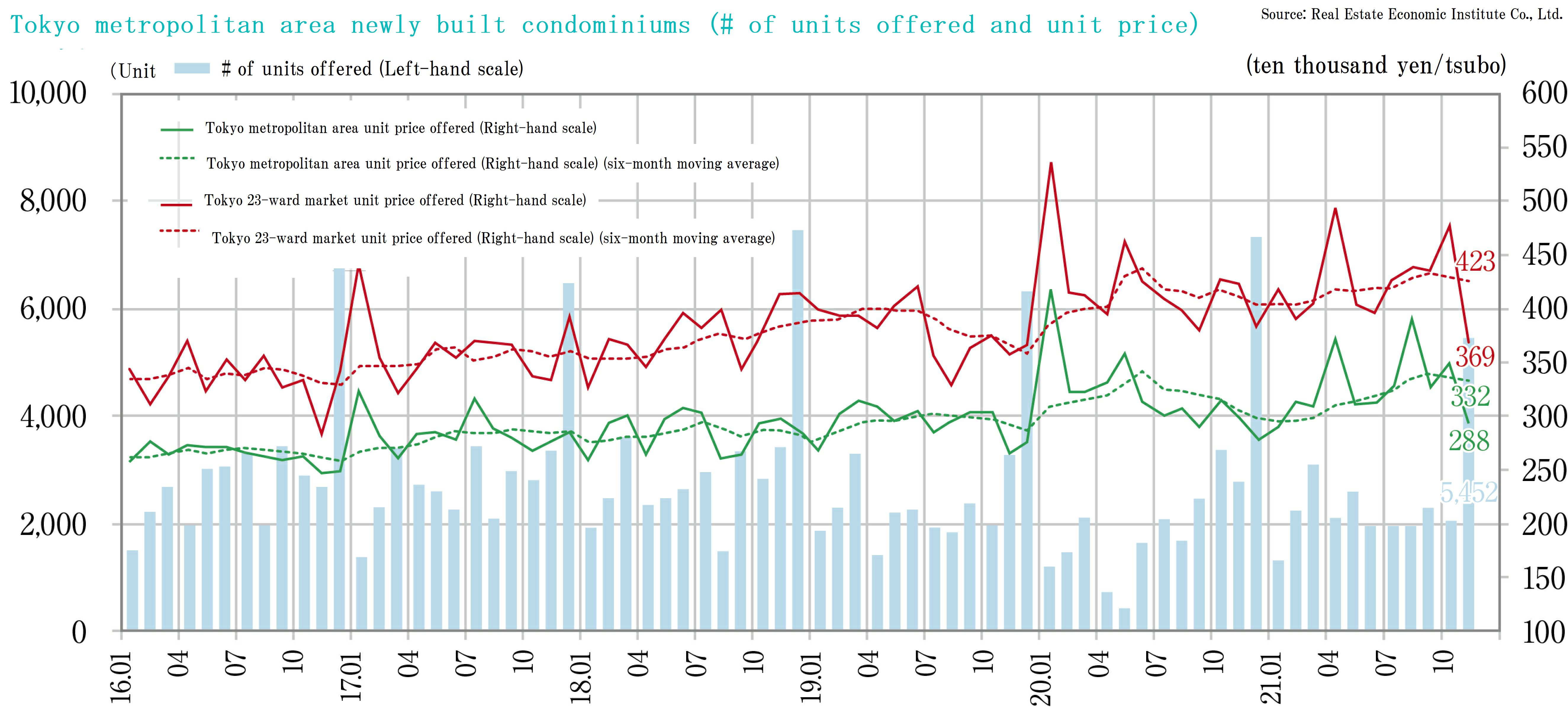
Data: As for new supply = Real Estate Economic Institute Co., Ltd., and as for secondary market = Real Estate Information Network for East Japan
Office
In-depth analysis of tenant needs and measures to fullfil them are indispensable to cope with a change in the way people work and large supply of office space in the pipeline.
■Large-scale office buildings in Tokyo CBD (Central 5 Wards)
・As of January 2022, the vacancy rate was 6.26%, improving by 0.07 ppt from the previous month.
・Average rent declined for 18 consecutive months. It was down from JPY 20,686 per tsubo in November 2021 to JPY 20,508 per tsubo in January 2022, registering a drop by 6.12% YoY.

■Vacancy rates, average rents in major regional cities / January 2022
・Sapporo: Vacancy @ 2.37%, down by 0.24 ppt MoM. Average rent up by JPY 17 MoM (Vacancy rate and average rent both improved.)
・"Sendai: Vacancy @ 6.09%, down by 0.50 ppt MoM. Average rent down by JPY 4 MoM (Vacancy rate improved, while average rent slightly deteriorated.)
・Yokohama: Vacancy @ 4.86%, up by 0.09 ppt MoM. Average rent up by JPY 4 MoM (Vacancy rate remained on the same level, while average rent slightly improved.)
・Nagoya: Vacancy @ 5.60%, down by 0.04 ppt MoM. Average rent up by JPY 63 MoM (Vacancy rate remained on the same level, while average rent improved.)
・Osaka: Vacancy @ 4.75%, up by 0.22 ppt MoM. Average rent up by JPY 72 MoM (Vacancy rate deteriorated, while average rent improved.)
・Fukuoka: Vacancy @ 4.45%, down by 0.08 ppt MoM. Average rent up by JPY 30 MoM (Vacancy rate remained on the same level, while average rent improved.)
Vacancy rates seem to have peaked out and average rents are in a rising trend.
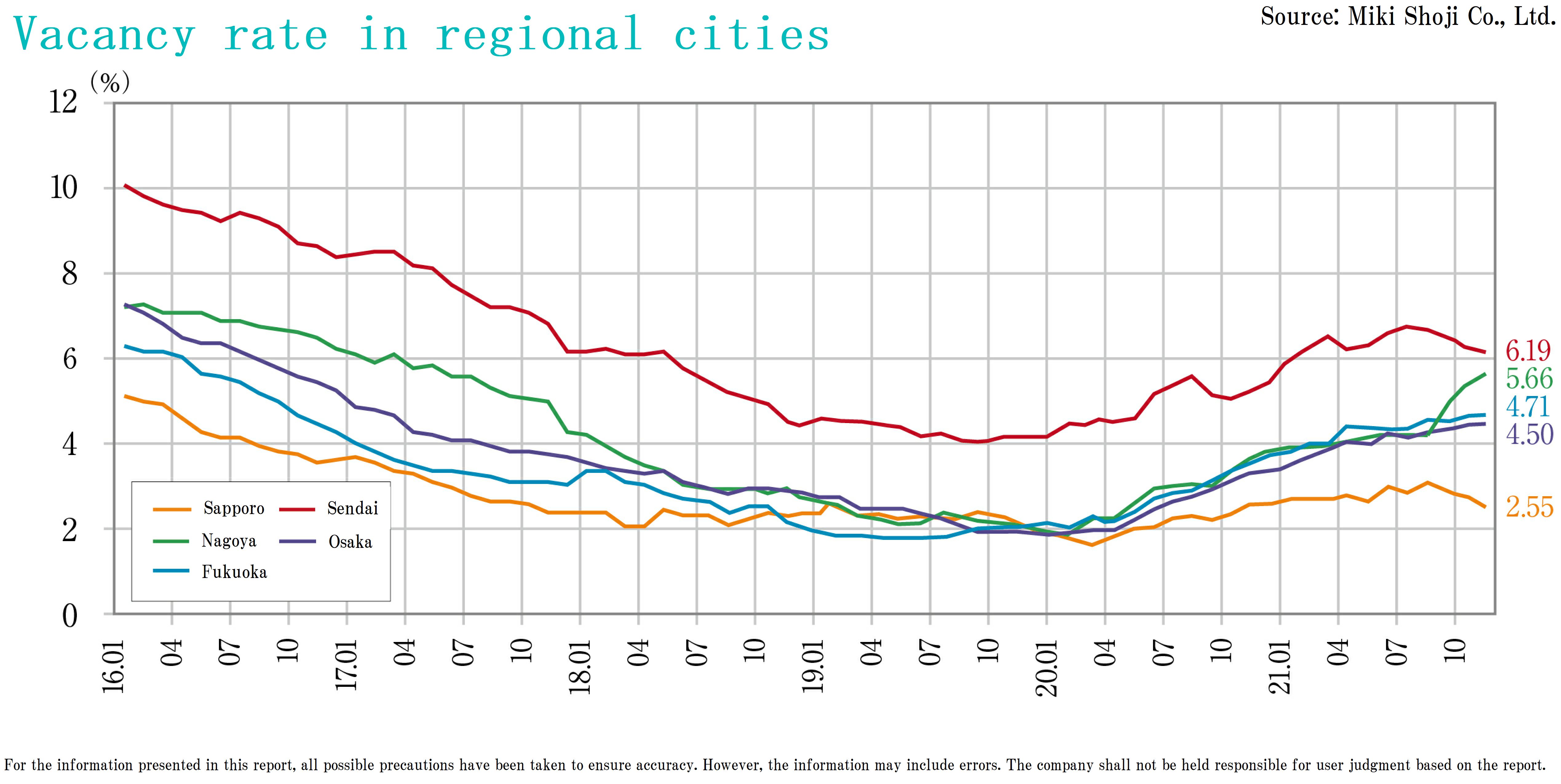
■Future market outlook
・As far as new office buildings in central Tokyo are concerned, a large volume of supply is slated mainly in Toranomon / Azabudai area for 2023, in Akasaka / Roppongi / Hamamatsucho area for 2024, and in Ya-esu / Nihonbashi / Kyobashi area for 2025, after the period of 2021 thru 2022 when the volume of supply was relatively held in check.
・Prestige of the area around Tokyo Station is unrivalled within Tokyo CBD market, and occupants are limited to top-ranking companies which can afford to pay high rents. New developments there are designed nowadays in order to attain "flexibility in office configuration," "furtherance of internal communication," and "advantage in recruitment strategy." In recent years, an increasing number of leading companies are adopting telecommuting and likely to reduce the size of their offices. It is a challenge in attracting tenants to adjust the characteristics of new office buildings to meet such needs.
Hospitality
Full recovery is eagerly anticipated, while the market is slowly improving.
There is a pressing need for measures to satisfy demand after COVID-19.
■Statistics by Japan Tourism Agency
・The total number of overnight guests was 39 million in December 2021, of which 320,000 were by foreigners. The annual total of overnight guests in 2021 is about the same as in 2020, and roughly half of that in 2019.
・Here is a breakdown by type of accommodations. 18.85 million guests stayed in business hotels, 5.39 million in resort hotels, and 5.95 million in city hotels. Business and resort hotels regained around 85% of the number in the same month of 2019 before COVID-19, while city hotels around 75%.
■Recent trend in business hotels
・Here is a recent trend in business hotels, which have the largest market share. Average occupancy rate plunged from 75.8% in 2019 to 41.5% in the first half of 2020. It was lingering around 30's and 40's until October 2021. The rate did not exceed 50% until the state of emergency was lifted in November / December. Then the recovery started.
■Future market outlook
・International premium brand hotels are eager to expand into Japan, and several luxury hotels which typically charge over JPY 100,000 per night are expected to open in 2022. Their target location are broadening from gateway cities such as Tokyo, Osaka, Nagoya and Fukuoka or world-renowned tourist destinations such as Kyoto and Okinawa to traditional resort areas such as Karuizawa, Hakone, Beppu and Kirishima.
・Many developers of international brand hotels are actually proceeding with development even under current situation speculating on the time after COVID-19. Domestic players will need to actively adopt effective measures with a view to securing market share.
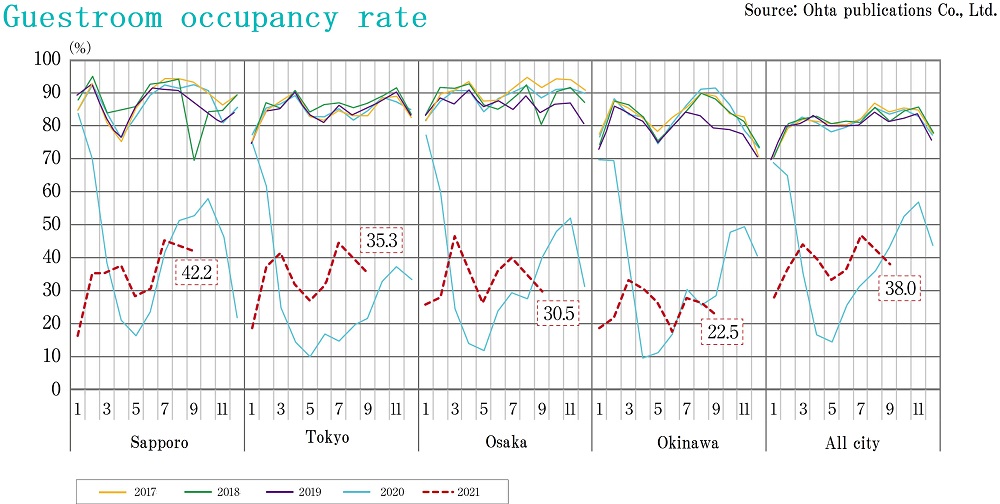
Commercial
Changes in buying behavior caused by prolonged COVID-19 pandemic and the rise of e-commerce have led to a shift in marketing policies.
■Sales volume and status quo of shopping centers
・Existing store sales for shopping centers (overall) in December 2021 were approximately JPY 606.4 billion (up 6.0% YoY). The increase in the sales figure is attributed to the declining number COVID-19 infections, consumption stimulated by year-end activities such as Christmas, and proactive sales promotion by shopping centers.
・Household income took an upward turn in 2015. Now having time to spare because of proliferation of work-from-home and self-quarantine, people tend to become fastidious about things to buy and happy to pay for added-value they find worthwhile. So one of the clues to breakthrough in the current state of the market is to catch the rising trend of such "premium consumption."
■Measures to rejuvenate department stores and shopping centers in Japan
・Many visitors enjoy the time spending at department stores and shopping centers. Setups such as sophisticated design of display and wrapping papers to evoke festive atmosphere and enhance the feeling of satisfaction are highly valued by them together with profuse hospitality.
・Department stores have out-of-store sales departments and marketing expertise accumulated over time that other types of retail traders don't have. By developing a new format to take advantage of such strength and stores specializing in tailored and customized merchandise, department stores are expected to attract new customers and stage a comeback.
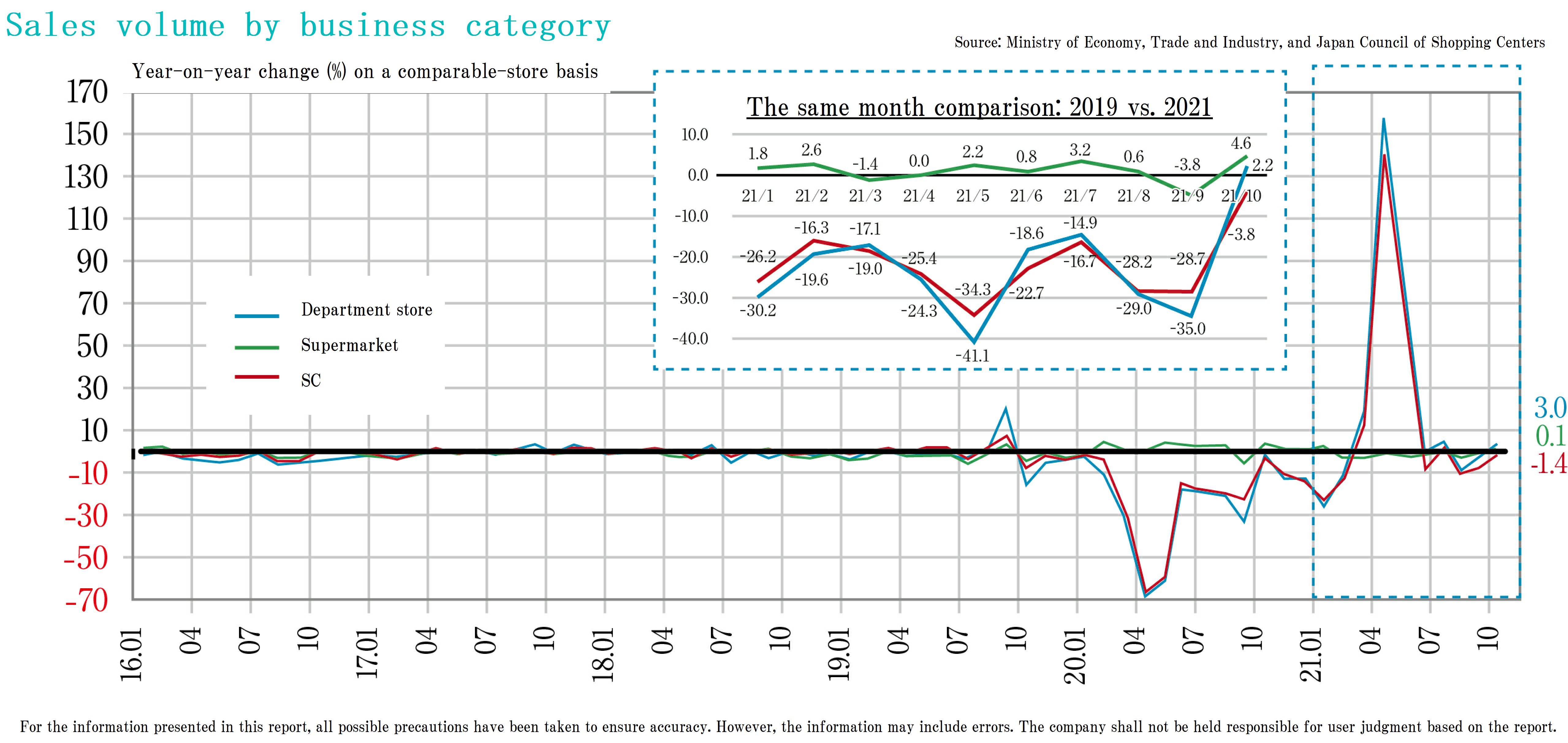
Logistics
Demand is steady in Tokyo metropolitan area, while a supply-demand situation is still tight in Kinki and Fukuoka regions. Growing e-commerce business will expand the market further.
■Market condition in Tokyo metropolitan area
・Vacancy rate for large multi-tenant logistics facilities (LMT) was 2.6% in 3Q. Despite concerns about the impact of the completion of several large-scale properties, vacancy rate is expected to stay around mid-two percent as demand remains strong.
・Effective rent was unchanged from 2Q at JPY 4,470 per tsubo.
・In Tokyo bay area, applications are being diversified away from logistics. For example, a facility within walking distance from a station is used as a studio utilizing high ceiling height.
■Market condition in other regions for 3Q
・In Kinki region, vacancy rate was 1.6% and effective rent was JPY 4,100 per tsubo. The vacancy rate declined for five consecutive quarters, and a supply-demand situation was very tight with new demand exceeding 90,000 tsubo.
・In Chubu region, vacancy rate was 7.9% and effective rent was JPY 3,590 per tsubo. Demand continued to expand.
・In Fukuoka region, vacancy rate remained at 0.0% since 2Q / 2019, and effective rent increased slightly to JPY 3,230 per tsubo. Development plans for new projects slated for 2023 on are taking definite shapes.
■Future market outlook
・According to the Ministry of Economy, Trade and Industry (METI), EC ratio (e-commerce sales to total retail sales) in the logistics market of Japan is 8.08%. EC ratio for the Food, Beverage, and Liquor category is only 3.3%, and future increase in this EC ratio will further expand the logistics market.
・The key to boost the EC ratio from now on is to build a network of last mile logistics while the market is crowded with major supermarkets such as Aeon and other e-commerce players such as Amazon and Rakuten. Urban facilities smaller than conventional ones will be much in demand.
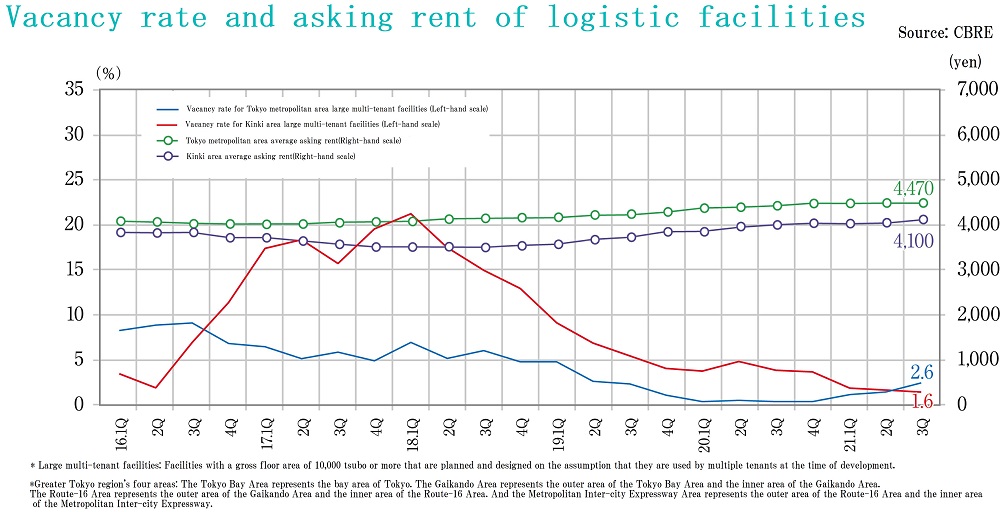
J-Reit
Tokyo Stock Exchange Reit Index and aggregate market capitalization of J-Reit's declined slightly. However, AUM expanded due to strong public offerings.
■J-Reit market trend
・As of the end of December 2021, the Tokyo Stock Exchange Reit Index stood at 2,066.33, down 3.9% from six months ago, while the aggregate market capitalization of J-Reit's also declined 3.0% to JPY 16.995.7 trillion at the same time.
・Investment unit prices remained sluggish due to such factors as the fourth declaration of emergency from mid-July till the end of September because of the spread of the delta strain, uncertainty about the time when office market would hit the bottom, and anticipation for early contraction of quantitative monetary easing and the interest rate hikes in the US.
・On the other hand, AUM of the J-Reit's reached JPY 21.239 trillion at the end of December, 2021, increasing by JPY 407.8 billion during the second half of the year as a result of continued strong public offerings following growth in investment unit prices during the first half of the year.
■Future market outlook
・Some office tenants started to relocate for the sake of better location and/or building specifications after the state of emergency was lifted in October. However, the market condition for office leasing still remains tough. Though there are signs that occupancy rate is bottoming out helped by reduction in evacuated area and leasing for the sake of occupancy, it is expected to take longer than estimated earlier for earnings to improve because of prolonged vacancy and free-rent periods, and contraction in rental increases or decline in rents due to reduced rent gaps.
・It is observed in the market that an increasing number of J-Reit's are reassembling portfolios. There is a marked tendency to avoid reduction in distribution by realizing capital gains to make up for a decline in rental revenue, or to set aside as retained earnings for the sake of stabilized distribution policy, taking advantage of brisk condition of the property trading market.








